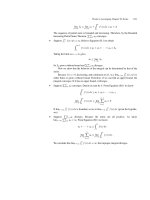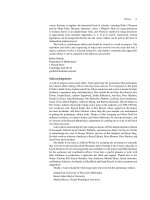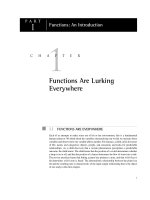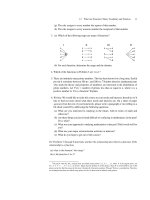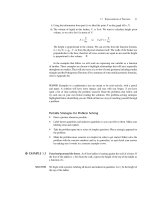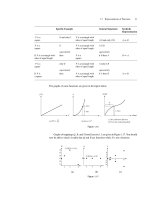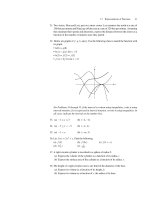Calculus: An Integrated Approach to Functions and their Rates of Change, Preliminary Edition Part 67 pdf
Bạn đang xem bản rút gọn của tài liệu. Xem và tải ngay bản đầy đủ của tài liệu tại đây (366.83 KB, 10 trang )
20.2 Triangles We Know and Love, and the Information They Give Us 641
◆
EXAMPLE 20.5 You’re interested in knowing the height of a very tall tree. You position yourself so that
your line of sight to the top of the tree makes a 60
◦
angle with the horizontal. You measure
the distance from where you stand to the base of the tree to be 45 feet. How tall is the tree?
(Assume that your eyes are five feet above the ground.)
SOLUTION We’ll begin with a sketch. It’s simplest to call the height of the tree x + 5 feet and find x.
5
60°
5 ft.
45 ft.
x
Figure 20.19
x
2
1
45
similar triangles
√3
3
π
3
π
tan (π/3) =
x
45
x = 45√3
x
45
√3 =
Figure 20.20
The tree is (45
√
3 + 5) feet tall, or approximately 82.9 feet tall. ◆
◆
EXAMPLE 20.6
(a) Find all x such that tan x =−1.
(b) Find all x such that sin x = 1/2.
(c) Find all x on the interval [0, 2π] such that cos x =−1/2.
SOLUTIONS (a) There are several approaches to solving tan x =−1. One approach is to use the unit
circle and interpret tan x as the slope of
OP . There are two points on the unit circle for
which the slope of
OP is −1. They are the points of intersection of the line v =−uand
the unit circle. The points correspond to x =
3π
4
and x =−
π
4
. Therefore, x =
3π
4
+2πn
or x =−
π
4
+ 2πn, where n is any integer.
642 CHAPTER 20 Trigonometry—Circles and Triangles
4
3π
P(
(
4
π
P(
(
v
u
–
Figure 20.21
(b) We begin by looking for one x-value that will satisfy sin x = 1/2. In our heads dance
visions of triangles we know and love. We draw one of our all-time favorites and see
that x =
π
6
fits the bill.
v
u
2
1
√3
2
1
2
√3
5π
6
π
6
π
6
π
6
π
3
(
(
,
P(
) =
2
1
2
√3
π
6
(
(
,
P(
) =
–
Figure 20.22
Draw P
π
6
on the unit circle. Now use the unit circle to find all points P with
v-coordinate 1/2. Using symmetry we see that
P
1
= P(π/6)=
√
3
2
,
1
2
and P
2
= P(5π/6) =
−
√
3
2
,
1
2
.
Therefore, if sin x = 1/2, then
x = π/6 +2πn or x = 5π/6 +2πn,
where n is an integer.
(c) We begin by looking for one x such that cos x =−1/2. In fact, to begin with let’s not
even worry about the negative sign. For what x is cos x = 1/2? Again, don’t turn to
strangers, turn to a triangle you know and love.
20.2 Triangles We Know and Love, and the Information They Give Us 643
v
u
2
1
√3
2
1
2
√3
π
3
(
(
,
P
1
=
–
2
1
(
2
√3
(
,
P
2
=
––
2
1
2
√3
3
π
3
π
(
(
,
Q
=
Figure 20.23
We see that cos(π/3) = 1/2. Let’s put that on the unit circle. We label it Q, because
it is not what we’re looking for. By symmetry considerations we can find two points,
P
1
and P
2
, with u-coordinate of −1/2. What are the values of x between 0 and 2π
that correspond to points P
1
and P
2
? The angle between
OQ and the positive u-axis
is π/3; the angle between
OP
1
and the negative u-axis is π/3 as well. Therefore,
P
1
= P(π −π/3) =P(2π/3).
We have to go halfway around the unit circle (π radians) to get from Q to P
2
.
Therefore, P
2
= P(π +π/3) =P(4π/3).
x =2π/3 and 4π/3
◆
Suppose we were interested in finding some x such that cos x = 0.3. In this case our
favorite triangles are useless. We do have a few tools at our disposal to approximate x;we
could approximate x using a calibrated unit circle or we could graph y =cos x and y = 0.3
on a graphing calculator and approximate a point of intersection. It would be much more
convenient, however, if we could just “undo” cosine; if we have the inverse function for
cos x at our disposal, we can express a solution exactly. We turn to inverse trigonometric
functions in Section 20.3.
PROBLEMS FOR SECTION 20.2
1. Find the following exactly.
(a) sin(π/6) (b) sin(π/4) (c) sin(π/3) (d) sin(−π/3) (e) cos(π/3)
(f) cos(−π/3) (g) tan(π/4) (h) tan(3π/4) (i) tan(5π/3) (j) sin(−7π/6)
2. (a) For what values of x is tan x =
√
3?
(b) For what values of x is tan(x) =−
√
3?
3. Find the exact values of the following.
(a) sin(2π/3) (b) cos(5π/4) (c) tan(7π/4) (d) sec(π/6)
(e) cot(−π/6) (f) csc(4π/3) (g) sin(801π) (h) cos(39π/4)
644 CHAPTER 20 Trigonometry—Circles and Triangles
4. (a) Find an acute angle x such that sin x = 0.5.
(b) Find all x between 0 and 2π such that sin x = 0.5.
(c) Find an acute angle x such that cos x = 0.5.
(d) Find all x ∈ [0, 2π] such that cos(2x) = 0.5.
5. Find the lengths of all the sides of the triangle drawn below.
2
π
3
6. Fill in the following table.
θ in degrees θ in radians sin θ cos θ tan θ
30
◦
45
◦
60
◦
7. Find exact values for each of the following. (No calculator—or use it only to check
your answers.)
(a) cos(π/4) (b) cos(5π/4) (c) cos(−3π/4)
(d) sin(5π/6) (e) sin(−13π/6) (f) cos(−2π/3)
8. A cross-section of a feed trough is shown below. Find the area of the cross-section.
Give an exact answer and then a numerical approximation.
60° 60°
2.5 ft
1.5 ft
9. Some kids are sitting on their stoop wondering about the height of a tall street post.
They estimate that the street post is casting a shadow 15 feet in length and that the angle
of elevation of the sun (from the ground) is about 60
◦
. Estimate the height of the street
post.
For Problems 10 through 14, rewrite each of the following expressions in terms of a
positive acute angle. This positive acute angle is sometimes referred to as a reference
angle.
10. (a) sin(−48
◦
) (b) cos(−48
◦
)
11. (a) sin 92
◦
(b) sin(−92
◦
)
20.3 Inverse Trigonometric Functions 645
12. (a) cos 130
◦
(b) cos(−130
◦
)
13. (a) cos 200
◦
(b) sin(200
◦
)
14. (a) tan 200
◦
(b) tan(−200
◦
)
20.3 INVERSE TRIGONOMETRIC FUNCTIONS
◆
EXAMPLE 20.7 A New York City lawyer is working on the case of an elderly woman who twisted her ankle
while chasing a runaway shopping cart down a ramp outside a Manhattan grocery store.
The curb is 6.5 inches high and the ground from the bottom of the curb to the end of the
ramp measures 50 inches. New York City law specifies that ramps must have a slope of no
more than 5 degrees. Was the construction of this ramp in accordance with the law?
11
6.5 "
50"
Figure 20.24
We need to find the acute angle x such that tan x =
6.5
50
, or tan x = 0.13. To solve for x
exactly we need to “undo” the tangent function. We can solve for x easily once we define
inverse trigonometric functions. We’ll do that and then return to the lawyer’s case.
◆
Inverse Functions Revisited
Given a function f , its inverse function, f
−1
, undoes f . Recall the following.
f has an inverse function only if f is 1-to-1; that is, each output value of the function
is taken on only once. If a function is not 1-to-1, we can restrict its domain so that it
becomes 1-to-1.
If f is 1-to-1, then f
−1
assigns to each output of f the unique associated input. We
look for a formula for the inverse function by writing y = f(x), interchanging x and
y (input and output) and solving for y.
The graph of f
−1
(x) can be obtained by interchanging the x- and y-coordinates for
every point on the graph of f . This is equivalent to reflecting the graph of y = f(x)
around the line y = x.
We want to define inverse functions for sin x, cos x, and tan x. Our first obstacle is that
none of these functions is 1-to-1. In fact, because they are all periodic, each output value
in the range corresponds to an infinite number of input values. We must restrict the domain
for each of them. We do so as follows.
11
This is a true story, facts, measurements, and all. My brother-in-law, the lawyer, called with the question.
646 CHAPTER 20 Trigonometry—Circles and Triangles
sin x
xxx
cos x tan x
1
1
–1
–1
ππ
2
π
2
–π
2
–π
2
(i)
(ii)
[0, π]
(iii)
sin x:
restricted
domains:
π
2
–π
2
x
[
[
,
cos x:
x
tan x:
π
2
–π
2
x
(
(
,
Figure 20.25
In every case we include the interval from 0 to π/2. For sine and cosine we use a
continuous half-cycle; for tan x we use an entire continuous cycle. Each of these restricted
domains includes all possible output values of the function. Think about the restricted
domains given; they’re fairly natural ones.
Once we have restricted the domains, we can obtain the inverse functions. Let’s start
with y = sin x. Interchanging the roles of x and y gives x = sin y. What is y? y is the
angle between −π/2 and π/2 whose sine is x. We call the inverse function inverse sine,
or arcsine, and denote it by sin
−1
x or arcsin x. Notice that arcsine gives as its output
an angle or a real number corresponding to a directed distance along the unit circle.
In radians the measure of the angle and the corresponding arc on the unit circle are
identical.
Recall the convention that sin
−1
x refers to the inverse sine function, not to (sin x)
−1
.
When discussing the reciprocal of sin x it is safest to write
1
sin x
or csc x.
We construct the definitions of the other inverse trigonometric functions, arccosine and
arctangent, similarly.
domain of sine
[−π/2, π/2]
range of arcsine
sin x
−→
←−
arcsin x
range
of sine
[−1, 1]
domain
of arcsine
domain of
tangent
(−π/2, π/2)
range of
arctangent
tan x
−→
←−
arctan x
range of
tangent
(−∞, ∞)
domain of
arctangent
The Inverse Trigonometric Functions
Definition
sin
−1
x is the angle between −π/2 and π/2 whose sine is x. domain of sin
−1
x:[−1, 1]
tan
−1
x is the angle between −π/2 and π/2 whose tangent is x. domain of tan
−1
x: (−∞, ∞)
cos
−1
x is the angle between 0 and π whose cosine is x. domain of cos
−1
x:[−1, 1]
20.3 Inverse Trigonometric Functions 647
Below are the graphs of the inverse trigonometric functions.
arcsin x
arccos x arctan x
x
x
x
1
–1
1
1
–1
–1
π
2
π
2
π
2
–π
2
–π
2
π
Figure 20.26
Observations
sin
−1
(sin x) = x if x ∈ [−π/2, π/2].
If x is not in [−π/2, π/2] this statement won’t hold. For example, sin
−1
(sin(2π)) =
sin
−1
(0) = 2π. The output of arcsine is always an angle between −π/2 and π/2.
sin(sin
−1
x) = x for all x in the domain of sin
−1
x.
tan
−1
(tan x) = x if x ∈ (−π/2, π/2).
tan(tan
−1
x) = x for all x (the domain of tan
−1
x is (−∞, ∞)).
cos
−1
(cos x) = x if x ∈ [0, π].
cos(cos
−1
x) = x for all x in the domain of cos
−1
x.
On most calculators the arcsine and sine functions share a key, the arccosine and cosine
functions share a key, and the arctangent and tangent functions share a key.
12
If A is positive, then
arcsin(A), arccos(A), and arctan(A) are all angles between 0 and π/2 (provided A is
in the function’s domain), and
arcsin(−A) =−arcsin(A), arccos(−A) = π−arccos(A), arctan(−A) =−arctan(A).
You can convince yourself of these last three statements by looking at a unit circle
together with the appropriate domain restrictions.
While it is possible to define inverses of sec x, csc x, and cot x, we will not do so. After
all, the equation sec x = A/B is equivalent to cos x = B/A.
Example 20.7 (continued)
Let’s return to Example 20.7, the problem of the grocery-store ramp and the runaway cart
in New York City. We were looking for the acute angle whose tangent is
6.5
50
, or 0.13. We
want to solve the equation tan x = 0.13. We can think about this in either of the following
ways:
x is the acute angle whose tangent is 0.13, so x = tan
−1
(0.13) ≈ 0.129 radians,
12
Just as you mightwonder how a calculator computes sin 1, you may wonder how your calculator arrives at arcsin(0.3). Again,
it is a good and interesting question. Again, the short and somewhat accurate answer is that it uses polynomial approximations of
arcsin x.
648 CHAPTER 20 Trigonometry—Circles and Triangles
or
tan x = 0.13. To undo the tangent, take the arctangent of both sides.
13
tan
−1
(tan x) =tan
−1
(0.13)
x = tan
−1
0.13 ≈ 0.129 radians
We must convert 0.129 radians to degrees in order to determine whether or not the ramp
was constructed in accordance with City law.
π radians = 180
◦
0.129 radians = 0.129(180
◦
/π) ≈ 7.4
◦
The ramp was not constructed in accordance with the law since 7.4
◦
is more than the
allowed 5
◦
.
◆
EXAMPLE 20.8 Simplify the following. Both a and b are positive constants.
(a) cos(arcsin(0.2)) (b) tan
cos
−1
−
a
b
(c) sin(cos
−1
(−a))
SOLUTION (a) cos(arcsin(0.2)) is the cosine of the angle θ ∈
−π
2
,
π
2
whose sine is 0.2.
Draw θ in a right triangle, as shown in Figure 20.27. We know θ ∈
0,
π
2
because
0.2 > 0. cos θ =
x
1
; solve for x.
x
2
+ (0.2)
2
= 1
2
x =
1 − (0.2)
2
=
√
0.96
cos θ =
√
0.96
1
=
√
0.96
x
1
.2
θ
Figure 20.27
(b) tan
cos
−1
−a
b
is the tangent of the angle θ ∈ [0, π] whose cosine is −
a
b
.
We know θ ∈
π
2
, π
because cos θ is negative. Therefore tan θ is negative as well. See
Figure 20.28.
tan θ =
x
−a
=
√
b
2
− a
2
−a
=
−
√
b
2
− a
2
a
13
Don’t even dream of getting rid of tan by dividing by tan. This would be mathematical blasphemy! tan x is NOT (tan)
times x.
20.3 Inverse Trigonometric Functions 649
x
y
a
b
√b
2
–a
2
θ
x =
Figure 20.28
(c) sin(cos
−1
(−a)) is the sine of the angle θ ∈ [0, π] whose cosine is −a.
We know θ ∈
π
2
, π
because cos θ is negative . Therefore sin θ is positive.
sin
2
θ + cos
2
θ = 1
sin
2
θ + a
2
= 1
sin θ =
1 − a
2
θ
(–a, sin θ)
sin θ = √1 –a
2
(sin
2
θ) + a
2
= 1
1
Figure 20.29
◆
PROBLEMS FOR SECTION 20.3
1. Evaluate each of the following expressions exactly. Do not give numerical approxima-
tions.
(a) sin
−1
(1) (b) tan
−1
(1) (c) sin
−1
(−1)
(d) cos
−1
(−1) (e) sin
−1
(−0.5) (f) cos
−1
(−0.5)
(g) tan
−1
(
√
3) (h)
cos
−1
(−1)
2
+
tan
−1
(−1)
2
2. Use the calibrated unit circle below to approximate the following. In each case, explain
in words how you used the calibrated unit circle to make your estimate.
(a) sin
−1
(0.8) (b) cos
−1
(0.6) (c) tan
−1
(2)
650 CHAPTER 20 Trigonometry—Circles and Triangles
3
2
4
.1 .2 .3 .4 .5 .6 .7 .8 .9
5
6
1
1
0.5
0.4
0.3
0.2
0.1
v
u
3. The function f(x)=tan x has an inverse function when its domain is restricted to
(−π/2, π/2).
(a) Graph y = tan
−1
(x). Where is the derivative positive? Negative?
(b) Is tan
−1
(x) an even function, an odd function, or neither?
(c) Is the derivative of tan
−1
(x) even, odd, or neither?
4. (a) Let h(x) = sin(sin
−1
(x)). What is the domain of h?Ish(x) = x for every x in its
domain? If not, for what x is sin(sin
−1
(x)) = x?
(b) Let j(x)=sin
−1
(sin(x)). What is the domain of j ? For which values of x is
j(x)=x?For which values of x is j(x)=x?(Caution: There are infinitely many
values of x for which j(x)=x.Besure to identify them all.)
5. On the same set of axes sketch the graphs of f(x)and f
−1
(x).
(a) f(x)=sin x, where x ∈ [−π/2, π/2].
(b) f(x)=cos x, where x ∈ [0, π].
6. Find the angle between π/2 and π whose sine is
(a) 0.5.
(b) 0.2. (Give an exact answer and then a numerical approximation.)
7. Simplify the following.
(a) sin
arctan
3
4
(b) tan(cos
−1
(0.5))
(c) cos(sin
−1
x), x<0
(d) tan
sin
−1
w
r
, w, r>0
